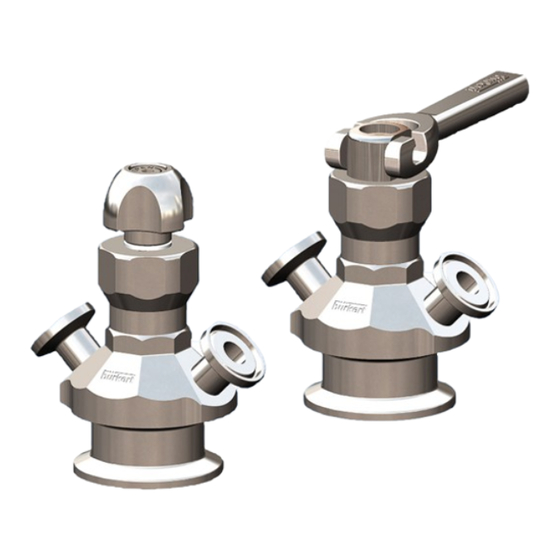
Table of Contents
Advertisement
Quick Links
Advertisement
Table of Contents

Summary of Contents for Burkert 3260
- Page 1 Type 3260 Sampling valve Operating Instructions...
- Page 2 We reserve the right to make technical changes without notice. © Bürkert Werke GmbH & Co. KG, 2023-2024 Operating Instructions 2405/02_ 00815459 / Original EN...
-
Page 3: Table Of Contents
Type 3260 Table of contents TABLE OF CONTENTS 1 About this document.......................... 4 Manufacturer............................. 4 Symbols ............................ 4 Terms and abbreviations ........................ 5 2 Safety ................................ 6 Intended use ............................. 6 Safety instructions .......................... 6 3 Product description ........................... 8 Product overview device with hand lever actuator ................ 8 Product overview device with handwheel actuator ................ 9... -
Page 4: About This Document
Before starting any work on the product, read and observe the respective sections of the document. Keep the document available for reference and give it to the next user. Contact the Bürkert sales office for any questions. Further information concerning the product at country.burkert.com. Manufacturer Burkert Fluid Control Systems (Jiangsu) Co., Ltd. -
Page 5: Terms And Abbreviations
Type 3260 About this document Terms and abbreviations The terms and abbreviations are used in this document to refer to following definitions. Device Sampling valve Type 3260 Unit for relative pressure... -
Page 6: Safety
Type 3260 Safety SAFETY Intended use Prerequisites for safe and trouble-free operation are correct proper transportation, storage, installation, start-up, operation and maintenance. The instructions are part of the device. The device is intended exclusively for use within the scope of these instructions. - Page 7 Type 3260 Safety Spare parts and accessories that do not meet Bürkert’s requirements may impair the operational safety of the device and cause accidents. To ensure operational safety, only use original parts from Bürkert. Working on the device Working on the device that has not been powered down, unauthorised switching on or uncontrolled start- up of the system can cause accidents.
-
Page 8: Product Description
Type 3260 Product description PRODUCT DESCRIPTION Product overview device with hand lever actuator Fig. 1: Device with hand lever actuator 1 Lever 2 Valve cap 3 Locking screw 4 Housing 5 Compressed spring 6 Axle sleeve 7 Bellows 8 Valve body... -
Page 9: Product Overview Device With Handwheel Actuator
Type 3260 Product description Fig. 2: Device with hand lever actuator 1 Locking screw for valve body Product overview device with handwheel actuator Fig. 3: Device with handwheel actuator 1 Handwheel 2 Housing 3 Compressed spring 4 Axle sleeve 5 Bellows 6 Valve body... -
Page 10: Product Identification
3260 D111 8,0 EE VH TG02 Pmed 6bar Tmed +10°C – + 130°C S/N 1234 93208788 W36LP Fig. 5: Type label Type 3260 (example) 1 Type 2 Actuator 3 Nominal diameter 4 Seal material 5 Body material 6 Port connection 7 Medium pressure... -
Page 11: Functionality
Type 3260 Product description Functionality The bellows is attached to the valve stem. The bellows is cleaned (or sterilised) when it is pressed against the sampling opening. The sample is taken when the bellows is removed from the sampling opening. -
Page 12: Technical Data
Type 3260 Technical data TECHNICAL DATA Operating conditions Ambient temperature +5...+90 °C Medium temperature +10...+130 °C Operating pressure 0...2.4 bar Relative air humidity < 98 %... -
Page 13: Installation
Type 3260 Installation INSTALLATION Risk of injury or material damage when working on the device or system. Read and observe the chapter Safety [} 6] before working on the device or system. Clean the pipe from dirt, debris, rust, etc. before installing the valve. -
Page 14: Commissioning
Type 3260 Commissioning COMMISSIONING Risk of injury or material damage when working on the device or system. Read and observe the chapter Safety [} 6] before working on the device or system. Before commissioning Before commissioning, test the installed valves to ensure proper function. -
Page 15: Maintenance
Type 3260 Maintenance MAINTENANCE Risk of injury or material damage when working on the device or system. Read and observe the chapter Safety [} 6] before working on the device or system. Sample valve maintenance mainly includes the following two aspects according to operational require-... - Page 16 Type 3260 Maintenance Open the hand lever or handwheel, close it again. Insert the bellows removal tool between the bellows and the cavity. Open the hand lever or handwheel again. The bellows can be removed. Before installing the new bellows, stretch and compress the new bellows by hand for 3 times.
-
Page 17: Troubleshooting
Type 3260 Troubleshooting TROUBLESHOOTING When replacing the bellows, tighten the hand lever or handwheel with a tightening torque of 40 N so that the contact surfaces lie flat on top of each other. Tighten the locking screw for valve body with a tightening torque of 0.8 N. -
Page 18: Accessories
Type 3260 Accessories ACCESSORIES Fig. 6: Bellows removal tool Accessories article number Bellows removal tool 93106811... -
Page 19: Transport And Storage
Type 3260 Transport and storage TRANSPORT AND STORAGE Store the device in a ventilated and dry environment. There must be no corrosive gases in the surround- ing atmosphere. Ensure that the device cannot turne over. Make sure the device is not exposed to vibrations. -
Page 20: Disposal
Type 3260 Disposal DISPOSAL At the end of the sampling valve's useful life (i.e. if the device is scrapped), disassemble the device and dispose of it properly sorted according to recyclable materials. Observe national regulations when disposing of materials. Improper disposal can cause environmental damage.












Need help?
Do you have a question about the 3260 and is the answer not in the manual?
Questions and answers